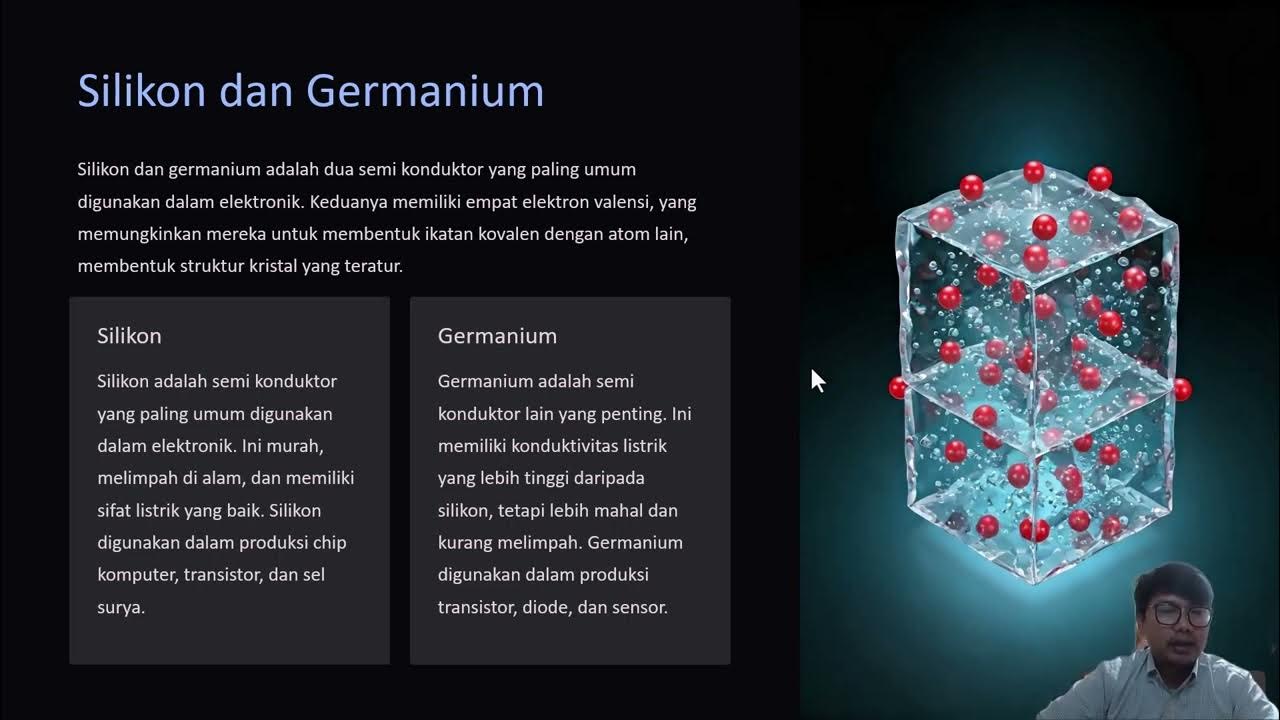Diodos: o guia básico para entender de forma fácil
Summary
TLDRIn this video, Professor Thiago introduces a new series on diodes, a key semiconductor device in electronics. He explains the basic operation of diodes, focusing on how they work in different polarizations—forward and reverse bias—and their role in circuits like rectifiers. Thiago covers various types of diodes, including rectifiers, fast diodes, LEDs, and Zener diodes, each with specific applications in electronics. He highlights the importance of understanding diodes for broader electronic concepts and encourages viewers to subscribe for more detailed lessons in the series.
Takeaways
- 😀 The speaker, Professor Thiago, starts his 2022 video series with new content focused on electronics, specifically diodes.
- 🔧 The video aims to explain basic concepts about diodes, starting from their function and gradually covering semiconductor physics and circuit applications.
- 🔋 Diodes are simple semiconductor devices with two terminals, an anode and a cathode, and are crucial for understanding electronics.
- ⚙️ Diodes work in two regions: forward bias, where they conduct current, and reverse bias, where they block current.
- 📉 In forward bias, a diode starts conducting current after a threshold voltage is reached, and its behavior becomes almost exponential.
- 🔀 The speaker simplifies diode modeling by treating it as an open switch below the threshold and as a voltage source above the threshold.
- 🔄 In reverse bias, diodes block current flow, but if the reverse voltage exceeds a certain point, breakdown occurs, potentially damaging the diode.
- ⚡ The video introduces the basic rectifier circuit, where diodes allow current to flow only in one direction, converting AC to DC.
- 💡 Various types of diodes are discussed, including general-purpose, fast, and signal diodes, each suited to different applications and performance characteristics.
- 💡 The speaker also touches on specific diode types like LED, Schottky, and Zener diodes, which have unique properties and applications in electronics.
Q & A
What is the main focus of the video?
-The main focus of the video is to explain the basic concepts of diodes, their functions, and their application in electronic circuits. It is part of a series that will cover the fundamentals of diodes and their role in electronics.
Why does the speaker consider diodes to be an important topic for discussion?
-The speaker believes diodes are important because they are fundamental components in electronics that have been neglected in previous videos on topics like transistors and operational amplifiers. Diodes help in understanding key electronic concepts and are useful in various circuits, such as power regulation and signal rectification.
What is a diode and how does it work?
-A diode is a semiconductor device with two terminals, an anode and a cathode, that allows current to flow in only one direction. When the anode is positive relative to the cathode (forward bias), the diode conducts electricity. When the cathode is more positive (reverse bias), it blocks the current.
How does a diode behave in forward and reverse bias?
-In forward bias (positive voltage on the anode), the diode initially does not conduct until a threshold voltage is reached. Once surpassed, current flows exponentially. In reverse bias (positive voltage on the cathode), the diode does not conduct, acting like an open switch, unless the reverse voltage exceeds a breakdown limit.
What is the 'breakdown' region in a diode?
-The breakdown region occurs when the reverse bias voltage exceeds the diode's breakdown voltage, causing it to conduct a large current, which can potentially damage the diode if not controlled. This region is typically avoided in circuit design.
What is the significance of the threshold voltage in a diode's operation?
-The threshold voltage is the minimum forward voltage required for the diode to start conducting. For silicon diodes, this is typically around 0.7V. Below this voltage, the diode behaves like an open circuit, and above it, the current increases rapidly.
What are some common types of diodes mentioned in the video?
-The video mentions several types of diodes, including rectifier diodes, fast diodes, signal diodes, Zener diodes, and Schottky diodes. Each type has unique properties suited for specific applications, such as power regulation or high-speed switching.
What is the function of a rectifier diode?
-A rectifier diode is used to convert alternating current (AC) to direct current (DC). It allows only one polarity of the AC signal to pass through, blocking the other polarity, effectively creating a unidirectional current.
What is a Schottky diode, and how does it differ from a standard silicon diode?
-A Schottky diode has a lower forward voltage drop (typically 0.3-0.5V) compared to standard silicon diodes (around 0.7V). This makes Schottky diodes more efficient for high-speed switching and low-voltage applications, as they dissipate less power.
What is the application of a Zener diode?
-A Zener diode is designed to operate in reverse breakdown without damage. It is commonly used for voltage regulation, as it maintains a stable output voltage regardless of variations in input voltage, protecting circuits from overvoltage.
Outlines

Dieser Bereich ist nur für Premium-Benutzer verfügbar. Bitte führen Sie ein Upgrade durch, um auf diesen Abschnitt zuzugreifen.
Upgrade durchführenMindmap

Dieser Bereich ist nur für Premium-Benutzer verfügbar. Bitte führen Sie ein Upgrade durch, um auf diesen Abschnitt zuzugreifen.
Upgrade durchführenKeywords

Dieser Bereich ist nur für Premium-Benutzer verfügbar. Bitte führen Sie ein Upgrade durch, um auf diesen Abschnitt zuzugreifen.
Upgrade durchführenHighlights

Dieser Bereich ist nur für Premium-Benutzer verfügbar. Bitte führen Sie ein Upgrade durch, um auf diesen Abschnitt zuzugreifen.
Upgrade durchführenTranscripts

Dieser Bereich ist nur für Premium-Benutzer verfügbar. Bitte führen Sie ein Upgrade durch, um auf diesen Abschnitt zuzugreifen.
Upgrade durchführenWeitere ähnliche Videos ansehen

Componentes Eletrônicos | ELETRÔNICA BÁSICA PARA INICIANTES #01 | Eletrônica Board

Device Physics I

Semiconductors - Physics inside Transistors and Diodes

Varactor (Construction & Working) Special Purpose Diode (Basic Electronics) BE/BTech 1st year

Pengantar Semi Konduktor

Homemade Tool Using a Cell Phone Charger with Which You Can Measure Any Electronic Component.
5.0 / 5 (0 votes)
